Editor’s Note: The following is extracted from Famous Sea Fights from Salamis to Tsu-Shima, by John Richard Hale (published 1911). All spelling in the original.
The Turk has long been known as the “sick man of Europe,” and the story of the Ottoman Empire for a hundred years has been a tale of gradual dismemberment. Thus it is no easy matter for us to realize that for centuries the Ottoman power was the terror of the civilized world.
It was in 1358 that the Ottomans seized Gallipoli, on the Dardanelles, and thus obtained their first footing in Europe. They soon made themselves masters of Philippopolis and Adrianople. A crusading army, gathered to drive the Asiatic horde from Europe, was cut to pieces by the Sultan Bajazet at Nicopolis in 1396. On the day after the battle ten thousand Christian prisoners were massacred before the Sultan, the slaughter going on from daybreak till late in the afternoon. The Turk had become the terror of Europe.
Constantinople was taken by Mahomet II in 1453, and the Greek Empire came to an inglorious end. Then for more than a century Austrians, Hungarians, and Poles formed a barrier to the advance of the Asiatic power into Central Europe.
But the Turks during this century became a maritime power. They had conquered the Crimea and were masters of the Black Sea. They had overrun Greece and most of the islands of the Archipelago. They had threatened Venice with their fleets, and had for a while a foothold in Southern Italy. They took Rhodes from the Knights of St. John, annexed Syria and Egypt, and the Sultan of Constantinople was acknowledged as the Khalifa of Islam, the representative of the Prophet by the Mohammedan states of North Africa—Tripoli, Tunis, and Morocco. In 1526 the victory of Mohacs made the Turks masters of Hungary. They had driven a wedge deep into Europe, and there was danger that their fleets would soon hold the command of the Mediterranean.
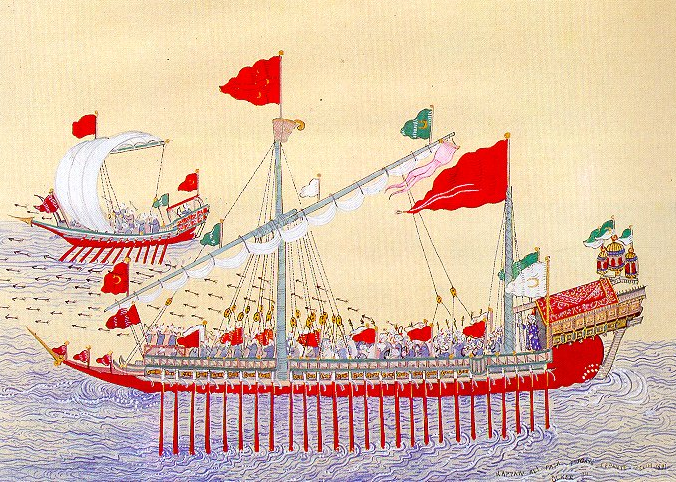
These fleets were composed chiefly of large galleys—lineal descendants (so to say) of the ancient triremes. There was a row of long oars on either side, but sail power had so far developed that there were also one, two, even three tall masts, each crossed by a long yard that carried a triangular lateen sail. The base of the triangle lay along the yard, and the apex was the lower corner of the triangular sail, which could be hauled over to either side of the ship, one end of the yard being hauled down on the other side. The sail thus lay at an angle with the line of the keel, with one point of the yard high above the masthead, and by carrying the sheet tackle of the point of the sail across the ship, and reversing the position of the yard, the galley was put on one tack or the other. Forward, pointing ahead, was a battery of two or more guns, and there was sometimes a second but lighter battery astern, to be used when the galley was escaping from a ship of superior force. Turks, in the Eastern Mediterranean, Moors in the West, recruited their crews of rowers by capturing Christian ships and raiding Christian villages, to carry off captives who could be trained to the oar. This piracy, plundering, and slave-hunting went on in the Mediterranean up to the first years of the nineteenth century, when, after the Turks themselves had long abandoned it, the sea rovers of the Barbary States in the western waters of the inland sea still kept it up, and European nations paid blackmail to the Beys of Tripoli, Tunis, and Algiers to secure immunity for their ships and sailors.
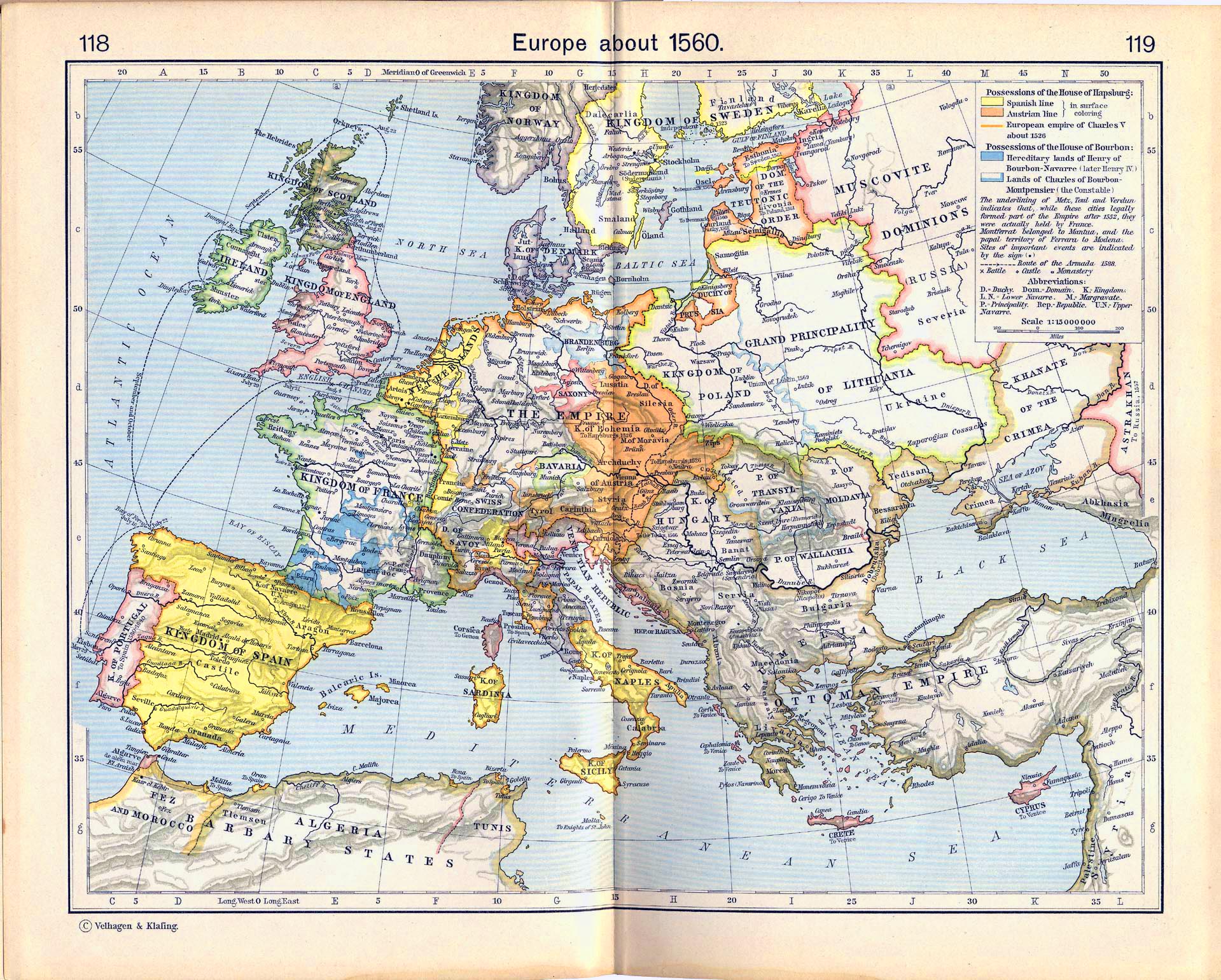
In the fifteenth and sixteenth centuries no part of the Mediterranean was free from the raids of the Moslem pirates. Such was the peril of the sea that ships used to carry two sets of sails, one white for use by day, the other black, in order to conceal their movements in the darkness. Thousands of Christian slaves were always wearing out their miserable lives in the galleys and prisons of the Mohammedan ports. Isolated expeditions were sometimes made by this or that Christian power for their deliverance. Two religious orders were founded to collect alms for their ransom, to minister to them in their captivity, and to negotiate for their deliverance. But all this was only a mitigation of the evil, and year after year there went on the enslavement of Europeans, men for the galleys, women for the harems.
One would have thought that all Europe would have banded itself together to drive back the Turk from the Danube and sweep the corsairs from the Mediterranean. To their honour be it said that successive Popes endeavoured to arouse the old crusading spirit, and band civilized and Christian Europe together for an enterprise that was to the advantage of all, and the neglect of which was a lasting disgrace. But their efforts were long defeated by the mutual quarrels and jealousies and the selfish policy of the European powers. Venice and Genoa long preferred to maintain peace with the Sultans, in order to have the undisturbed monopoly of the Eastern trade. France was too often the ally of the Turk, thanks to her traditional rivalry with the House of Austria, the rulers of the German Empire. The pressure of Turkish armies on the Eastern frontiers of the Empire made it impossible for the Emperors to use their full strength on the Rhine or in North Italy.
Again and again Rome uttered the cry of alarm, and the warning passed unheeded. But at last it was listened to, when a new outburst of aggressive activity on the part of the Turks for a while roused the maritime nations of the Mediterranean from their lethargy, and then a glorious page was added to the story of naval warfare.
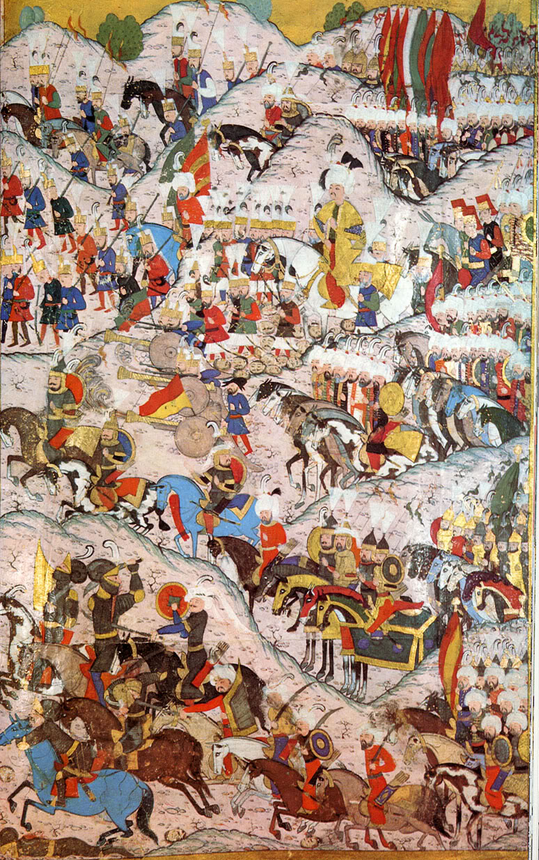
In the year 1566 Suleiman the Magnificent died. He had conquered at Mohacs and besieged Vienna, enlarged the boundaries of the Ottoman Empire on land, and made its fleets the terror of the Mediterranean; but the year before he died his pashas had failed disastrously in their attempt on Malta, and his successor, Selim II (whom Ottoman historians surname “the Drunkard”), was reported to be a half-imbecile wretch, devoid of either intelligence or enterprise. So Europe breathed more freely. But while the “Drunkard” idled in his seraglio by the Golden Horn, the old statesmen, generals, and admirals, whom Suleiman had formed, were still living, and Europe had lulled itself with false hopes of peace.
For the sake of their Eastern trade interests the Venetians had as far as possible stood neutral in the wars between Turk and Christian, and had long been in undisturbed possession of Cyprus. For eighty years they had held it under a treaty that recognized certain rights of the Sultan to the island as a dependency of Egypt. They had stood neutral while Suleiman took Rhodes and besieged Malta, though on either occasion the intervention of the Venetian fleet would have been a serious blow to the Ottoman power. The Venetian Senate was therefore disagreeably surprised when an envoy from Constantinople demanded the evacuation of Cyprus, and announced that the Sultan intended to exercise his full rights as sovereign of the island. The armaments of the Republic were at a low ebb, but Doge and Senate rejected the Ottoman demand, and defied the menace of war that accompanied it.
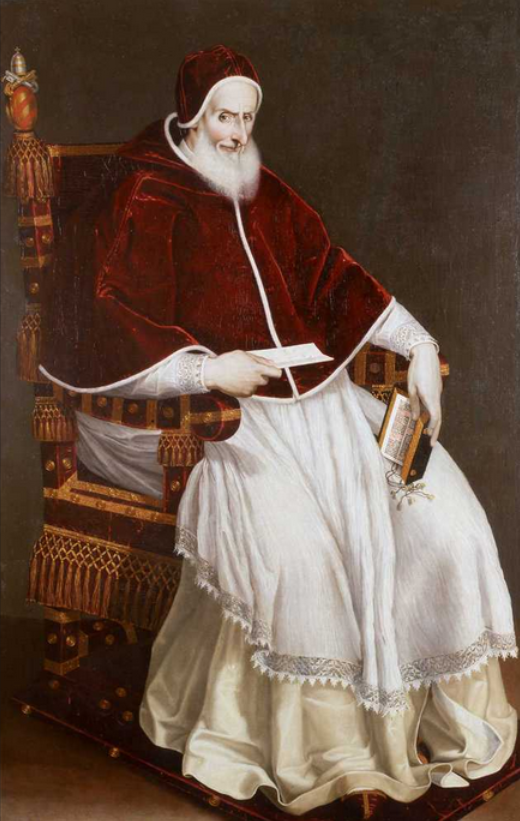
The neutrality of Venice had been the chief obstacle to the efforts of Pius V to form a league of the maritime powers of Southern Europe against the common enemy of Christendom. When, therefore, the Venetian ambassadors applied to the Vatican for help, the Pope put the limited resources of his own states at their disposal, and exerted his influence to procure for them help from other countries. Pius saw the possibility of at last forming a league against the Turk, and was statesman enough to perceive that a more effective blow would be struck against them by attacking them on the sea than by gathering a crusading army on the Theiss and the Danube.
His own galleys were prepared for service under the orders of Prince Colonna, and a subsidy was sent to Venice from the papal treasury to aid in the equipment of the Venetian fleet. The papal envoys appealed to the Genoese Republic, the Knights of Malta, and the Kings of France and Spain to reinforce the fleets of Rome and Venice. But France and Spain were more interested in their own local ambitions and jealousies, and even Philip II gave at first very limited help. With endless difficulty a fleet of galleys was at last assembled, Maltese, Genoese, Roman, Venetian, united under the command of Colonna. By the time the Christian armament was ready a larger Turkish fleet had appeared in the waters of Cyprus and landed an army, which, under its protection, began the siege of Nicosia. After long delays Colonna’s fleet reached Suda Bay in Crete, and joined a squadron of Venetian galleys kept for guardship duties in Cretan waters.
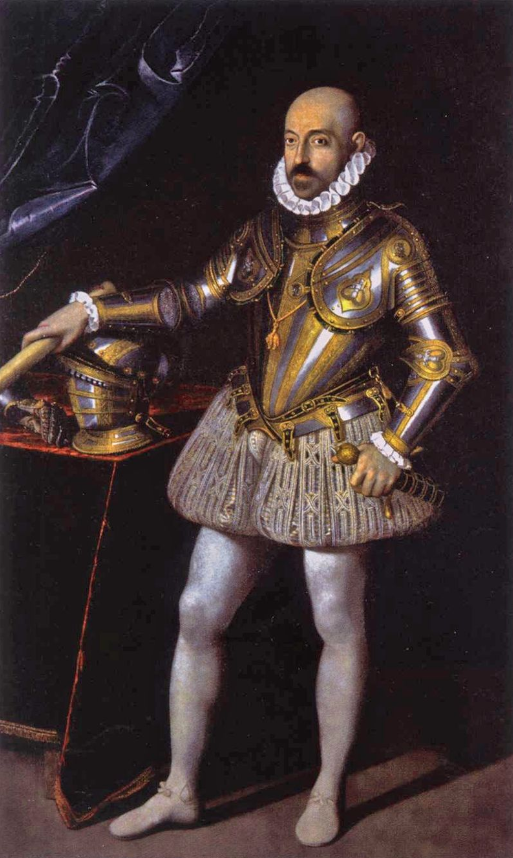
Though Colonna was in nominal command, the fleet was really controlled by a committee of the chiefs of its various squadrons. There were endless councils of war, and it is a trite saying that “councils of war do not fight.” Prudent caution is oftener the outcome of such debates than daring enterprises. There was a time, in the first days of September, when, if the Suda fleet had gone boldly to the relief of Nicosia, it might have raised the siege, for the Venetian garrison was making such a vigorous defence that in order to press the siege the Turkish pashas had stripped their fleet of thousands of fighting-men to employ them in the trenches. But the golden opportunity passed by, and when at last Colonna took his galleys across to the coast of Asia Minor, Nicosia had fallen, and the Turks had begun the siege of the other Cypriote fortress, Famagusta.
Again there were divided counsels and pitiful irresolution. The commanders of the various contingents were brave men, veterans of the Mediterranean wars. But the coalition lacked one determined leader who could dominate the rest, decide upon a definite plan of action, and put it into energetic execution. Time was wasted till the bad weather began. Then the various squadrons made their way to the ports where they were to pass the winter. A squadron of the Venetians remained in the Cretan ports. The rest dispersed to the harbours of Italy and the Ionian islands.
The aged pontiff heard with bitter disappointment that nothing had been accomplished. The news might well have made even a younger man lose heart. But with undaunted courage he devoted himself to forming a more powerful combination for the great effort of the coming summer.
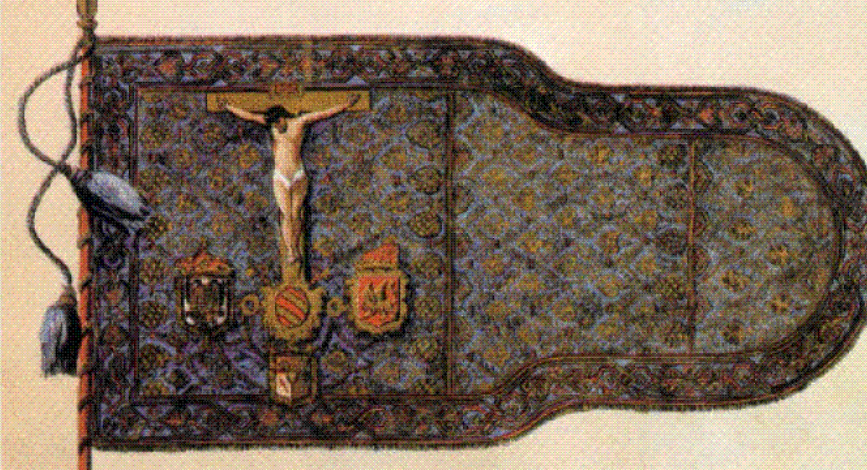
It was all-important to secure the alliance of the King of Spain, who was also ruler of Naples and Sicily. But it was only after long negotiations and smoothing away of endless jealousies between Spain and Venice, that at last the treaty of the “Holy League” was signed by the Republic of Venice, the King of Spain, and the Pope, Pius V undertaking to bring in help from the minor Princes and Republics of Italy and the Knights of Malta.
It was proposed that there should be a fleet of three hundred ships, of which two hundred were to be galleys and a hundred navi, that is full-rigged sailing-ships. It was the first time that the sailing-ship had been given so important a place in naval projects in the Mediterranean, and this shows the change that was rapidly coming into naval methods. The allies were jointly to raise a force of 50,000 fighting-men, including 500 gunners.
Once the treaty was arranged preparations were pushed forward, but again there were wearisome delays. It was easy enough to build galleys. The arsenal of Venice had once laid a keel at sunrise and launched the galley before sunset. But to recruit the thousands of oarsmen was a longer business. It was not till well into the summer of 1571 that the armada of the Holy League began to assemble at the appointed rendezvous, Messina. Meanwhile, the Turks were pressing the siege of Famagusta, blockading it by land and sea, and sapping slowly up to its walls. The heroic commandant of the place, Antonio Bragadino, a worthy son of Venice, made an active defence, retarding by frequent sorties the progress of the enemy’s siege works.
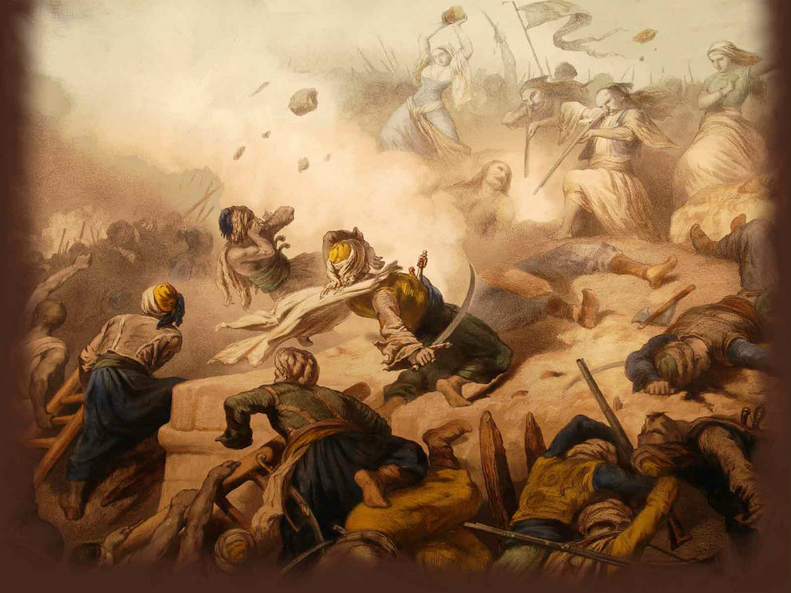
By the month of June the Turks had lost nearly 30,000 men, including those who fell victims to the fever that raged in their camps. Bragadino’s garrison had been thinned by the enemy’s fire, by sickness, and by semi-starvation, and at the same time the magazines of ammunition were nearly empty. Behind the yawning breaches of the rampart an inner line of improvised defences had been erected, and the citadel was still intact. If he had had a little more flour and gunpowder, Bragadino would have held out as stubbornly as ever. But with starving men, empty magazines, and no sign of relief, he had to accept the inevitable. He sent a flag of truce to Mustapha Pasha, the Ottoman general, and relying on the impression made by his stubborn defence, asked for generous terms.
Mustapha professed a chivalrous admiration for the heroism of the Venetians. It was agreed that the garrison should march out with the honours of war, and be transported under a flag of truce to Crete and there set at liberty. The Ottoman general pledged himself to protect the people of Famagusta, and secure for them the free exercise of their religion.
The war-worn soldiers marched out. Bragadino, with the Venetian nobles, were received at Mustapha’s tent with every mark of honour. But no sooner had the officers been separated from their men, and these divided into small parties, than all were made prisoners, bound, and robbed of all their personal property. The Turks had often shown remorseless cruelty after victory, but they generally observed the terms of a capitulation honourably. Mustapha’s conduct was an unexampled case of treachery and barbarity.
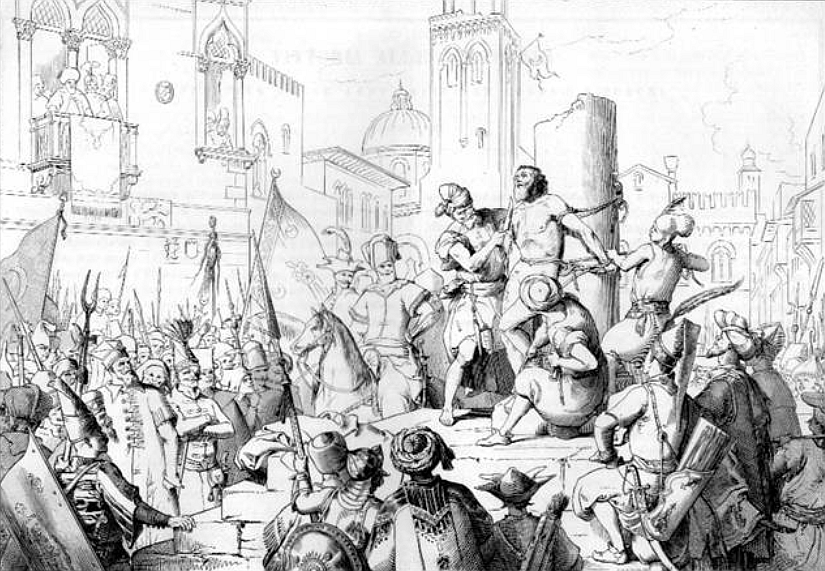
The Venetian soldiers were sent on board the Turkish galleys and chained to their oars as slaves. Bragadino saw his officers beheaded before the Pasha’s tent. He might have saved his life by becoming a renegade, but he was incapable of such apostasy and treason. The barbarian, in whose power he was, invented new torments for his victim. Bragadino had his ears and nose cut off, and thus mutilated he was paraded round the Turkish army, and then rowed in a boat through the fleet, and everywhere greeted with insult and mockery. Then Mustapha sentenced his prisoner to be flayed alive. The torture had hardly begun when he expired, dying the death of a hero and a martyr. Mustapha sent to Selim the Drunkard as trophies of the conquest of Cyprus the heads of the Venetian nobles and the skin of Bragadino stuffed with straw. The news of the fall of Famagusta and the horrors that followed it did not reach the allied fleet till long after it had sailed from Messina.
But even during the period of preparation there were tidings that might well have inspired the leaders of the League with a new energy. The danger from the East was pressing. In the spring the Ottoman fleet in the waters of Cyprus had been reinforced with new galleys from the arsenal of Constantinople, and a squadron of Algerine corsairs under the renegade Pasha Ulugh Ali, one of the best of the Turkish admirals. Thus strengthened, the fleet numbered some two hundred and fifty sail. Even before Famagusta fell Mustapha detached powerful squadrons which harried the Greek archipelago, and then rounding the capes of the Morea, made prizes of peaceful traders and raided villages along the western shores of Greece and in the Ionian islands.
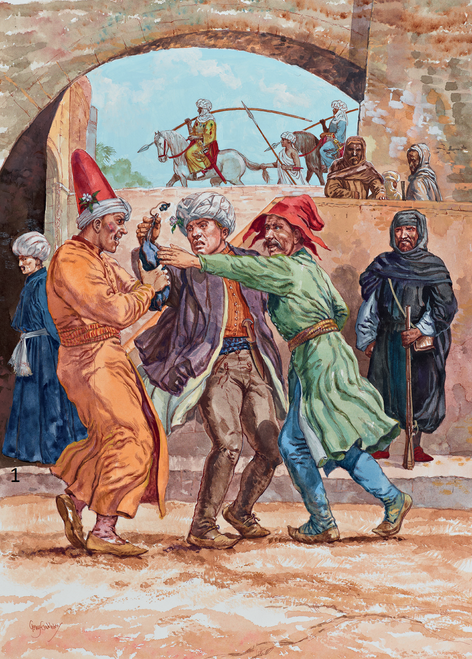
During the period of the Turkish power Europe was saved again and again from grave danger, because the Ottoman Sultans and the Pashas of Barbary never seem to have grasped the main principles of maritime warfare. They had no wide views. Most of the men who commanded for them on the sea had the spirit of pirates and buccaneers rather than of admirals. They put to sea to harry the trade of the Christian states and to raid their coast villages, and so secure prizes, plunder, and slaves. They frittered away their strength on these minor enterprises. Again and again occasions offered, when to concentrate their naval forces for a series of campaigns that would sweep the Christian fleets one by one from the sea would have made them masters of the Mediterranean, placed its commerce and its coasts at their mercy, and opened the way for a career of conquest, but they allowed these opportunities to escape.
The peril that menaced European civilization in 1571 was that at last the Moslem powers of the Mediterranean were actually combining their sea forces for a great effort of maritime conquest. Their operations were still delayed by their traditional disposition to indulge in plundering raids, or to wait for the fall of a blockaded fortress, instead of making the destruction of the opposing sea power their first object. If the pashas of Selim’s fleets had really understood their business, they might have destroyed the Christian squadrons in detail before they could effect their concentration in the waters of Messina. But the Turkish admirals let the opportunity escape them during the long months when the “Holy League” was being formed and its fleets made ready for action.
That the danger was met by the organization of a united effort to break the Moslem power on the sea was entirely due to the clear-sighted initiative and the persistent energy of the aged Pius V. He had fully realized that the naval campaign of 1570 had been paralysed by the Christian fleet being directed, not by one vigorous will, but by the cautious decisions of a permanent council of war. He insisted on the armament of 1571 being under the direction of one chief, and exercising his right as chief of the League, Pius V had to select the commander of its forces; he named as captain-general of the Christian armada Don Juan of Austria.
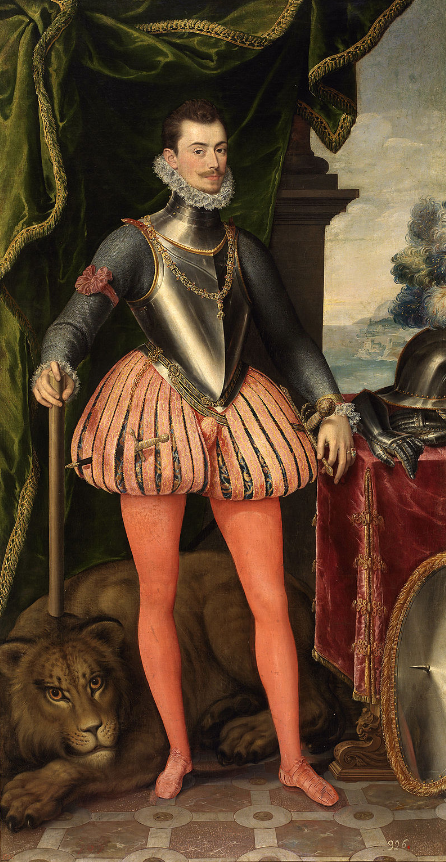
Don Juan was then a young soldier, twenty-four years of age. He was the son of the Emperor Charles V and his mistress, Barbara Blomberg of Ratisbon. His boyhood had been passed, unknown and unacknowledged by his father, in a peasant household in Castille. As a youth he had been adopted by a noble family of Valladolid. Then Philip II had acknowledged him as his half-brother, and given him the rank of a Spanish Prince. He studied at Alcala, having for his friends and companions Alexander Farnese, the “Great Captain” of future years, and the unfortunate Don Carlos. Don Juan’s rank gave him early the opportunity of displaying in high command his marked genius for war. He was employed in expeditions in the Mediterranean, and directed the suppression of the Moorish revolt in Granada in 1570. He was then named “Capitan-General del Mar”—High Admiral of the Spanish fleets. Young as he was when Pius V appointed him commander-in-chief of the forces of the Holy League, his services by land and sea, as well as his princely rank, gave him the necessary prestige to enable him to command even older generals like Marco Antonio Colonna, the leader of the papal and Italian forces, and the veteran Sebastian Veniero, who directed those of Venice.
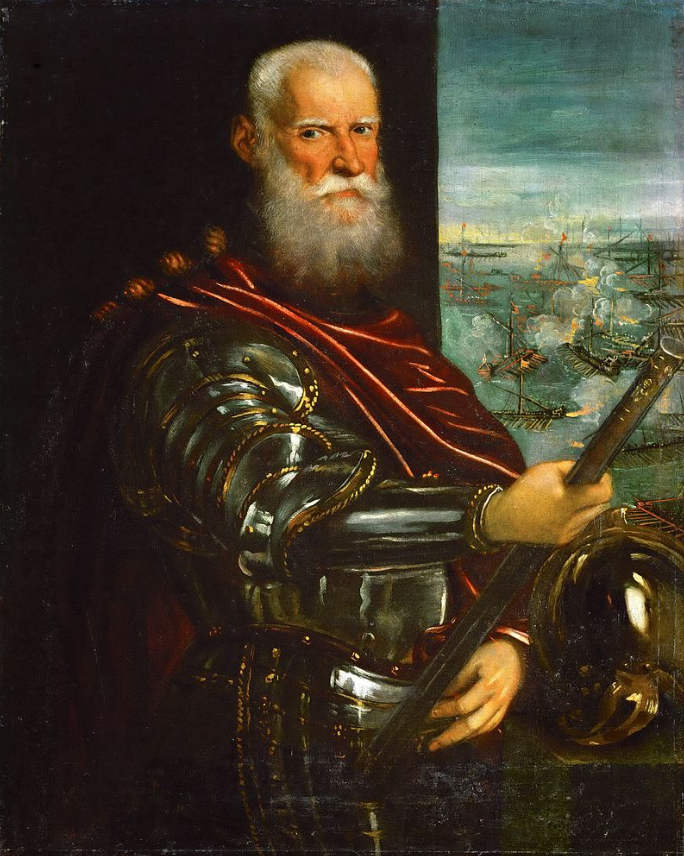
During the period of concentration it was Veniero who had the most difficult problem to solve. The Venetian fleet had separated into two divisions at the close of the campaign of 1570. The weaker wintered in the harbours of Crete. The stronger detachment passed the winter at Corfu, in the Ionian islands. In the early summer of 1571 Veniero took command at Corfu, and occupied himself with preparing the fleet for sea, and reinforcing it with new galleys from the arsenal of Venice, and newly raised drafts of sailors, rowers, and fighting-men. Before his preparations were complete, the vanguard of the Turkish armada, continually reinforced from the East, appeared on the western coasts of Greece. To attack them with the force he had at hand would be to court destruction. Ulugh Ali, who commanded the vanguard of the enemy, was perhaps the best-hated of the Moslem admirals. A Calabrese fisherman, he had been captured as a young man by one of the Barbary corsairs, and spent some miserable years chained as a galley-slave at an oar. At last his endurance broke down, and he escaped from his misery by becoming a Mohammedan. Under his new name he rose rapidly to command, enriched himself by successful piracy, and before long won himself the rank of a Pasha and a vice-royalty in North Africa. But, happily for Europe at large, though unfortunately for many a village along the shores of Greece and Illyria, Ulugh Ali as admiral of the Turkish fleets remained still a pirate, with the fixed idea that a plundering cruise was better than a naval campaign. Had the renegade been more admiral than pirate, he had an opportunity of changing the course of history in that early summer of 1571.
His fleet cruising off the coasts of Epirus held a central strategic position in relation to the still dispersed Christian fleets. The papal contingents on the western shores of Italy and the Spanish fleets in the ports of the Two Sicilies, or coasting from Spain by the Gulf of Lyons and the Italian shores, were, it is true, beyond his immediate reach, but he could easily lop off one important branch of the triple League by cutting off the Venetians. The squadron from Crete must pass him to the southward; the more important contingent from Corfu must pass between him and Southern Italy in narrow seas where he could hardly fail to bring it to action, and if it fought, the chances were he would overwhelm it. Or he might attack it at Corfu, or drive it from the island back upon Venice. If he had good luck he might hope to be in time even after this to strike a blow also at the Cretan squadron.
But he thought only of plundering and burning along the coasts, carrying off crowds of prisoners, some of whom were at once added to his crews of chained rowers. Veniero at Corfu had to steel his heart against entreaties to come to the rescue of the mainland coast population. He could not save them, and he dared not destroy his fleet in a hopeless effort. He must seize the opportunity while the Turks were occupied with their raids to sail unopposed to Messina. He decided even to risk the loss of Corfu. He was acting on the sound principle that in war all minor objects must be sacrificed to the chief end of the campaign. But he could not be sure that in obeying his original orders, and taking his fleet to Messina, he was not in another way risking his position, perhaps his life. He was leaving to the Turks the temporary command of the Adriatic. After he left Corfu they carried fire and sword along the Illyrian coast. There was a panic in Venice, and the city of the lagoons made hasty preparations for defence. But Veniero’s action was soon justified. The news that the Christian armada was assembled at Messina alarmed Ulugh Ali into abandoning any further enterprises in the Adriatic, and his squadrons withdrew to join the concentration of the Turkish fleets at the entrance of the Gulf of Corinth.
It was not till 23 August that the Spanish Prince arrived at Messina, took command of the assembled fleets, and proceeded at once to organize his forces, and issued his sailing and battle orders.
Nearly three hundred ships crowded the harbour of Messina. There were three fleets, the Italian squadrons under the papal admiral Colonna, the Venetian fleet, and the fleet of Philip II formed of the ships of Spain and Naples. The main force of the three fleets was made up of galleys. But there were also six galleasses and some seventy frigates, the former depending chiefly, the latter entirely, on sail power for propulsion. The frigate was, in the following century and almost up to our time, what the cruiser is in the armoured navies of to-day. But in the Mediterranean fleets of the fifteenth century the frigata represented only an early type, out of which the frigate of later days was developed. She was a small sailing-ship, sometimes a mere yacht, armed only with a few light guns. The frigates were used to convey stores, the swifter among them being often employed as dispatch boats. Depending entirely on the wind, it was not always easy for them to accompany a fleet of galleys. Don Juan gave up the idea of making them part of his fighting fleet. It was still the period of the oar-driven man-of-war, though the day of sails was close at hand.
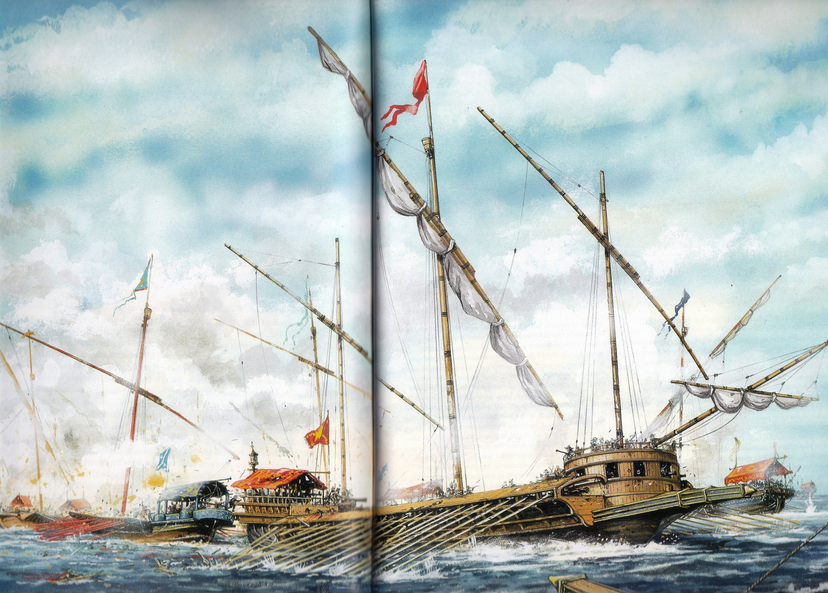
The six galleasses represented a new type, a link between the oared ships of the past and the sailing fleets of the immediate future. They were heavy three-masted ships, with rounded bows, and their upper works built with an inward curve, so that the width across the bulwarks amidships was less than that of the gundeck below. The frames of warships were built on these lines till after Nelson’s days. This “tumble home” of the sides, as it was called, was adopted to bring the weight of the broadside guns nearer the centre line of the ship, and so lessen the leverage and strain on her framework. The guns had first been fired over the bulwarks, but at a very early date port-holes were adopted for them. The galleass had a high forecastle and poop, each with its battery of guns, pointing ahead, astern, and on each side. Other guns were mounted on the broadsides in the waist of the ship; and to command the main-deck, in case an enemy’s boarders got possession of it, lighter guns were mounted on swivels at the back of the forecastle and on the forepart of the poop. Compared to the low, crowded galley, the galleass was a roomy and much more seaworthy ship. She was generally a slow sailer, but in order to enable her to make some progress, even in calms or against a head wind, and so work with a fleet of galleys, she had a rowers’ deck, under her main or gundeck, and on each side twelve or fifteen oars of enormous length, each worked by several men. She had the drawbacks of most compromises. She could not sail as well as the frigate, and her speed with the oar was much less than that of the galley. But the gain was that she could be used as a floating battery, carrying many more guns than the few pieces mounted in the galley’s bows. The galleass’s guns were high above the water, and the galleys dreaded their plunging fire. Each of Don Juan’s six galleasses carried some thirty guns of various calibres, and to defend their high sides against an attack by boarders, their fighting-men were chiefly arquebusiers.
In order to fuse the triple fleet of the Allies into one armada, and to avoid the risk of international jealousies, Don Juan proceeded to form his galleys into five squadrons, each made up of ships selected from the three fleets, so that none of these divisions could claim to act only for Rome, or Spain, or Venice.
The organization of the Christian armada may be thus summed up in tabular form:—

It is interesting to note that instead of choosing one of the large sailing-vessels as his flagship, Don Juan displayed his flag, the standard of the League, from the masthead of the largest of the Spanish galleys, the “Reale,” a splendid ship built for the Viceroy of Catalonia three years before. She had sixty oars, a battery of guns pointing forward through a breastwork in the bow, and another gun on her high poop, pointing over her stern, which was adorned with elaborate wood carvings, the work of Vasquez of Seville, one of the most famous sculptors of the day. She had a crew of 300 rowers and 400 fighting-men. In the battle-line two other great galleys were to lie to right and left of the “Reale,” on her starboard, the flagship of Colonna, the papal admiral, and to port that of Veniero the Venetian, flying the lion banner of St. Mark. Next to these were the galleys of the Princes of Parma and Urbino. On the extreme right of the centre was the post of the flagship of the Knights of Malta, commanded by the Grand Master Giustiniani. All the galleys of the central squadron flew blue pennons as their distinguishing flag.
The vanguard and the right flew green triangular flags. When the line was formed Cardona and his seven galleys were to take post on the left or inner flank of the right division. Doria, the Genoese admiral, was on the extreme right.
The left flew yellow pennons. Its admiral was the Venetian Barbarigo, a veteran of many a hard-fought campaign.
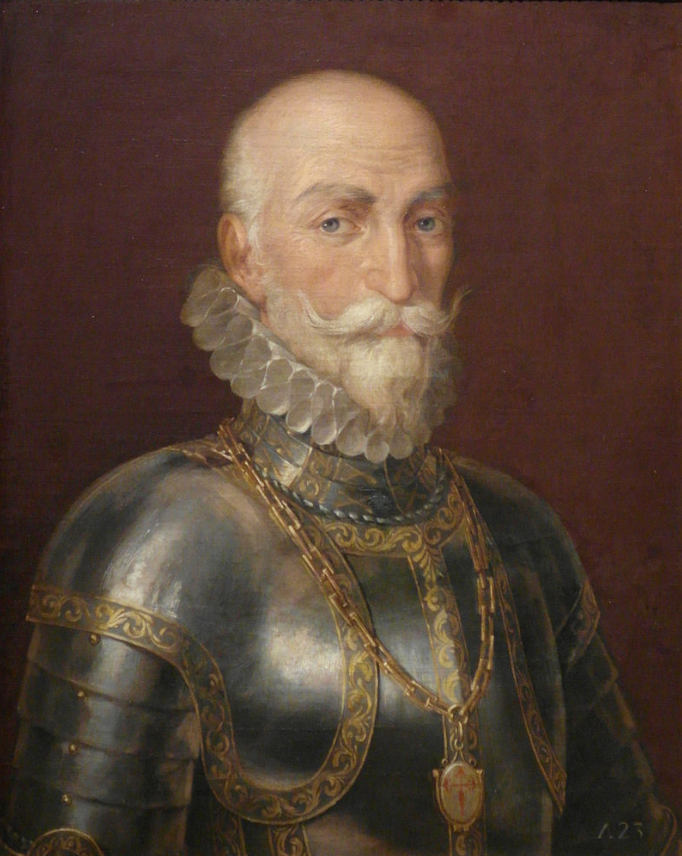
Santa Cruz, the admiral of the reserve squadron, was posted in the middle of his line, flying his flag on board the “Capitana” or flagship of the Neapolitan squadron. All the flagships had as a distinctive mark a long red pennon at the foremast-head.
Twenty-eight thousand fighting-men were embarked on the fleet. The Italian soldiers were the most numerous, then came the Spaniards. There were about 2000 of other nationalities, chiefly Germans. The Venetian galleys were rather short of fighting-men, and to remedy this weakness Veniero, though with some reluctance, consented to receive on board of them detachments of Don Juan’s Spanish infantry.
On almost every ship there were serving a number of young gentlemen volunteers. To give a list of their names and of the commanders of galleasses and galleys and detachments of troops embarked would be to draw up a roll of the historic names of Italy and Spain. Lepanto might well be described as not only the closing battle of crusading days, but the last battle of the age of chivalry. And, strange to say, on board of one of Colonna’s galleys, acting as second in command of its fighting-men, there was a young Spaniard who was to “laugh Europe out of its chivalry”—Don Miguel Cervantes de Saavedra, author of “Don Quixote” some thirty years later.
At the end of the first week of September the fleet was ready for sea, but the start was delayed by bad weather. For several days a storm raged in the Straits of Messina, accompanied by thunder and lightning and torrents of rain. At length, on the 14th, the sky cleared and the sea went down. Next day Don Juan sent off the squadron of frigates under the command of Don Cesar d’Avalos, with orders to proceed to Taranto and await the main body of the fleet there.
At sunrise on the 16th the great fleet left Messina. The “Reale” led the way; the tall galleasses were towed out by the galleys. It took some hours for the whole armada to clear the harbour, then, on the admiral’s signal, they set their sails, and with wind and oar steered south-westward across the straits. The first day’s voyage was only a few miles. Don Juan was taking the opportunity of reviewing his fleet, and testing his arrangements for its formation. Each captain had his written orders giving his position when under way and in the line of battle. It was in this formation the fleet anchored along the Italian coast beyond Reggio, on a front of five miles.
Next day the fleet rounded Cape Spartivento, the toe of Italy, and after an attempt to continue the voyage on the 19th was forced by bad weather to put back and anchor under shelter of the land for some twenty-four hours.
As the weather improved, Don Juan decided not to coast round the Gulf by Taranto, but to lay his course from Cape Colonna for Cape Santa Maria (the heel of Italy), and then across the opening of the Adriatic to Corfu. A frigate was sent to inform D’Avalos of the change of plans, and the armada, helped by a favouring wind, stood out to sea and for a while lost sight of land.
It was known that the Turkish fleet had concentrated in or near the opening of the Gulf of Corinth. It might also have put to sea, and Don Juan took precautions in view of a possible encounter during his voyage. Cardona, with his seven swift galleys of the vanguard, was directed to keep twenty miles ahead during the daytime, closing in to a distance of only eight miles at sunset, and increasing the interval again at dawn. The three squadrons of the main body appear to have been formed each in line ahead, the leading ships, those of the admirals, at the head of each squadron, with such lateral intervals between the columns that line of battle could be formed, by the ships coming up to right and left of their flagships. Santa Cruz with the reserve acted as a rearguard, and was to assist any vessel that might be in difficulties. The rear ship of each squadron was to display a large lantern at the mast-head after dark. The admiral’s ship was distinguished by three large lanterns.
Forty galleys were detached to bring reinforcements of infantry from Taranto and Gallipoli. Four swift galleys under the command of Gil d’Andrada were sent on in advance to obtain information of the Ottoman fleet.
From Cape Santa Maria the course was set for the Ionian Islands. On the morning of 24 September, through the driving rain that accompanied a heavy thunderstorm, the look-outs of the vanguard could distinguish the chain of islands north of Corfu, the islets of Merlera, Fano, and Samothraki, which with the reefs that almost connect them form a natural breakwater. The wind and sea were rising, and the fleet anchored inside the shelter of the islands and reefs. It was not until 26 September that it reached at length the harbour of Corfu. It had taken ten days to complete a passage that the tourist from Messina to Corfu now covers in a single day.
At Corfu the commandant of the fortress had terrible tales to tell of Ulugh Ali’s raid on the island, and the horrors that the Turks had perpetrated in the villages, which now presented a scene of ruin and desolation. Gil d’Andrada rejoined the fleet there. He had not seen the Turkish armament, but he had obtained news of it from coasters and fishermen. He estimated from these reports that it was inferior in numbers to the Christian fleet, and he had learned that, as if conscious of its weakness, it had taken shelter well up the Gulf of Corinth, in the Bay of Lepanto. The bay lies eastward of the point where the gulf contracts into a narrow strait between the “Castles of Roumelia” and “the Morea,” then held by the Turks. The defences were of such strength that at the time the strait was popularly known as “the Little Dardanelles.” It was thought that it would be hopeless for the allied fleet to attempt to force the passage.
Four days were spent in the waters of Corfu, and 4000 troops of the garrison were embarked. Gil d’Andrada’s four galleys had again been sent away to reconnoitre the enemy. On 30 September the weather was fine and the wind favourable, so Don Juan led his fleet from Corfu to the Bay of Gomenizza, thirty miles to the south-east, on the coast of Albania. The galeasses guarded the entrance of the bay; the galleys were moored inside it, bow on to the shore, with their guns thus directed towards it. Working parties were landed under their protection to obtain supplies of wood and water. On 2 October some Spaniards engaged in the work were surprised and made prisoners by Turkish irregulars, Albanian horsemen, who carried them off to the headquarters of Ali Pasha, the Turkish generalissimo, at Lepanto.
Gil d’Andrada rejoined at Gomenizza with news that the Turkish fleet was not more than 200 strong; that pestilence had broken out among its fighting-men, and that many of the galleys were undermanned. This encouraged Don Juan to attempt an attack upon it as it lay in the gulf.
But Ali Pasha had also received reports that led him to underrate the strength of the Christian armada, and so induced him to put out to sea in search of it. Twice he had reconnoitred the allied fleet. Before Don Juan arrived at Messina, Ulugh Ali had sent one of his corsairs, Kara Khodja, to cruise in Sicilian waters. The corsair painted every part of his ship a dead black, and one dark night, under black sails, he slipped into Messina harbour. The utter daring of his enterprise assisted him. Gliding like a ghost about the roadstead, unmarked and unchallenged, he counted galleys, galleasses, and frigates, and brought back an under-estimate of the allied strength, only because the fleet was not yet all assembled. He repeated his exploit while the fleet lay in the waters of Corfu. He could not approach so closely as at Messina, but what he saw led him to believe it was no stronger than when he first reconnoitred it. When Ali Pasha questioned the prisoners taken at Gomenizza, using torture to make them answer him, he thought their admissions confirmed Kara Khodja’s reports. So he decided to come out of Lepanto and attack the allied armada.
Thus each fleet believed the other to be inferior in strength, and consequently desired an early engagement. The Turkish fleet was made up of 210 galleys and 64 galliots and smaller craft, 274 sail in all, and its commander, Ali Pasha, was one of the veteran admirals of Suleiman’s victorious days; 25,000 soldiers had been embarked under the Seraskier, or General, Pertev Pasha. Ali had organized his fleet in four divisions, centre, right wing, left wing, and reserve. All the ships had oars as well as sails, and though Ali had no huge floating batteries, like the six galleasses of Don Juan’s fleet, the Turkish admiral could match the Christians with galley for galley, and have a surplus of 8 galleys and 66 smaller craft. Of these the 44 galliots were almost as useful as the galleys. Unlike the latter, which had two and often three masts, the galliot had only one, and was smaller in size. But the Turkish galliots, mostly belonging to the piratical states of North Africa, were as large as many of the Christian galleys of the second class; they could sail well, and they were manned by crews of fighting-men that had a long record of piratical warfare.
The organization of Ali’s fleet was:—

The fifty galleys of the right wing were ships from Egypt, the ports of Asia Minor, and the arsenal of Constantinople, united under the command of Mohammed Chuluk Bey, Governor of Alexandria, known among the Christian sailors of the Mediterranean as Mohammed Scirocco. The centre, commanded by Ali in person, was made up of galleys from Rhodes and the Greek islands, and from Constantinople and Gallipoli, and the Tripolitan squadron under Djaffir Agha, Governor of Tripoli. The left under Ulugh Ali, the Viceroy of Algiers, included ships from Constantinople, Asia Minor, Syria, and the ports of North-west Africa. The reserve, chiefly composed of small craft, was under the command of Murad Dragut of Constantinople.
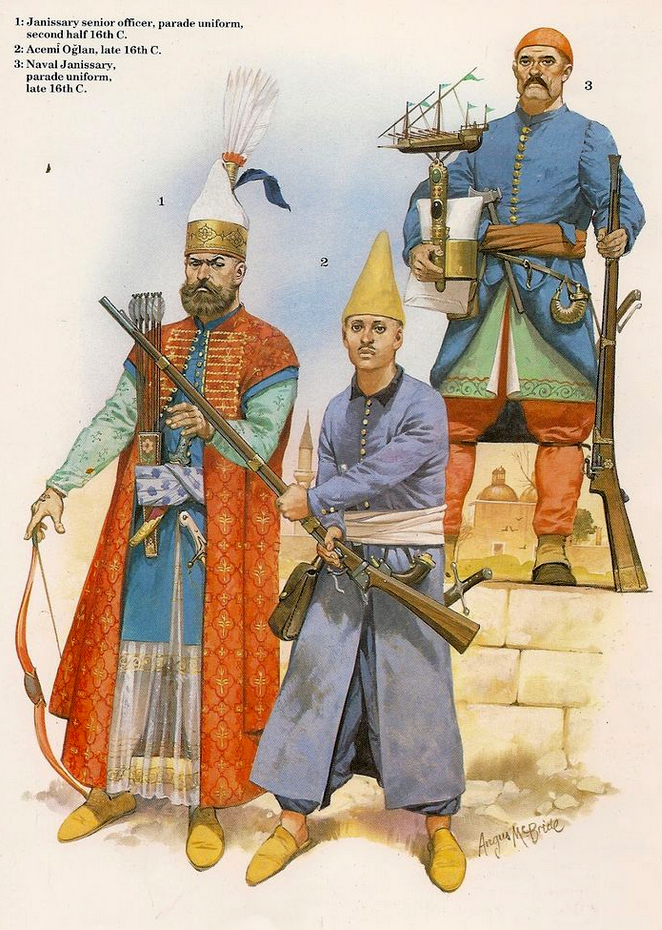
There were a good many Greek and Calabrese renegades among the captains of the galleys, but the Syrians and the mixed Arab race of Alexandria had learned the ways of the sea; some even of the Turks were good sailors, and the men of Tripoli, Tunis, and Algiers had made the sea their element. The thousands of rowers, who provided the propelling power of the galleys, were for the most part Christian slaves, chained to their heavy oars, by which they slept when the fleet anchored, living a life of weary labour, often half starved, always badly clothed, so that they suffered from cold and wet. Death was the immediate penalty of any show of insubordination, and the whip of their taskmasters kept them to their work. There were men of all classes among them, sailors taken from prizes, passengers who had the bad luck to be on board captured ships, fishermen and tillers of the soil carried off in coast raids. They were short-lived, for their masters did not spare them, and considered it a more economic policy to work the rowers to the utmost and replace them by other captures when they broke down.
The oarsmen of the allied fleet had also a hard lot, but not as bad as that of Ali Pasha’s galley-slaves, because in the Christian fleet there was a considerable proportion of men hired for the campaign. But there was also a servile element, Turks taken prisoner in previous campaigns and chained to the oar in reprisal for the treatment of Christian captives by Ottoman commanders, and a considerable number of what we should now call convicts sentenced to hard labour, a rough lot of murderers, brigands, thieves, and the like. It must be remembered that in most European countries the sentence for such offences would have been death. The convict galley-slaves of Don Juan’s fleet were encouraged by the prospect of winning either complete pardon or a remission of part of their sentences if there was a victory, and to enable them to co-operate in winning it, they were told that they would be freed from their chains and armed when the day of battle came.
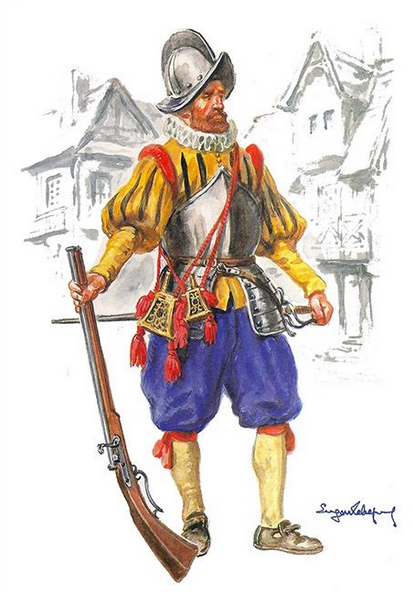
The 25,000 fighting-men of Ali Pasha’s fleet were chiefly militia. There were only a few thousand of the formidable Janissaries. And among the small arms of the Turkish fleet there were more bows and arrows than muskets. Don Juan had, on the other hand, a considerable number of arquebusiers on his ships. He had the further advantage that while even the largest of the Turkish galleys had only low bulwarks, the galleys of the allied fleet were provided with pavesades, large bucklers and shields, to be fitted along the bulwarks when clearing for action, and also permanent cross barriers to prevent a raking fire fore and aft.
When Ali left the roadstead of Lepanto, and brought his fleet out from behind the batteries of the “Little Dardanelles,” he believed he had such a marked superiority over the allied fleet that victory was a certainty, and he expected to find Don Juan either at Gomenizza or in the waters of the Ionian Islands. Pertev Pasha and several of the admirals had opposed Ali’s decision, and had urged him either to remain at Lepanto, or run out of the gulf, round the Morea, and wait in the eastern seas for the campaign of next year. Their reason for this advice was that many of the fighting-men were new levies unused to the sea. But Ali’s self-confidence made him reject this prudent counsel.
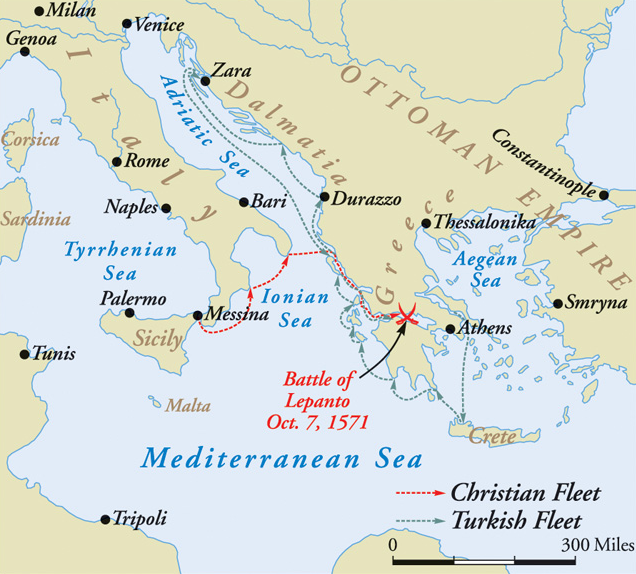
On 2 October, Don Juan had made up his mind to leave Gomenizza, enter the Gulf of Corinth, and risk an attack on the passage of the Little Dardanelles. Accordingly in the afternoon he gave orders that the fleet should prepare to sail at sunrise next day. During the long delay in the island waters belated news came that Famagusta had fallen on 18 August, and with the news there was a terrible story of the horrors that had followed the broken capitulation. The news was now six weeks old, and this meant that the whole of the enemy’s fleet might be concentrated in the Gulf of Corinth, but after the disasters of Cyprus an attempt must be made to win a victory against all or any odds.

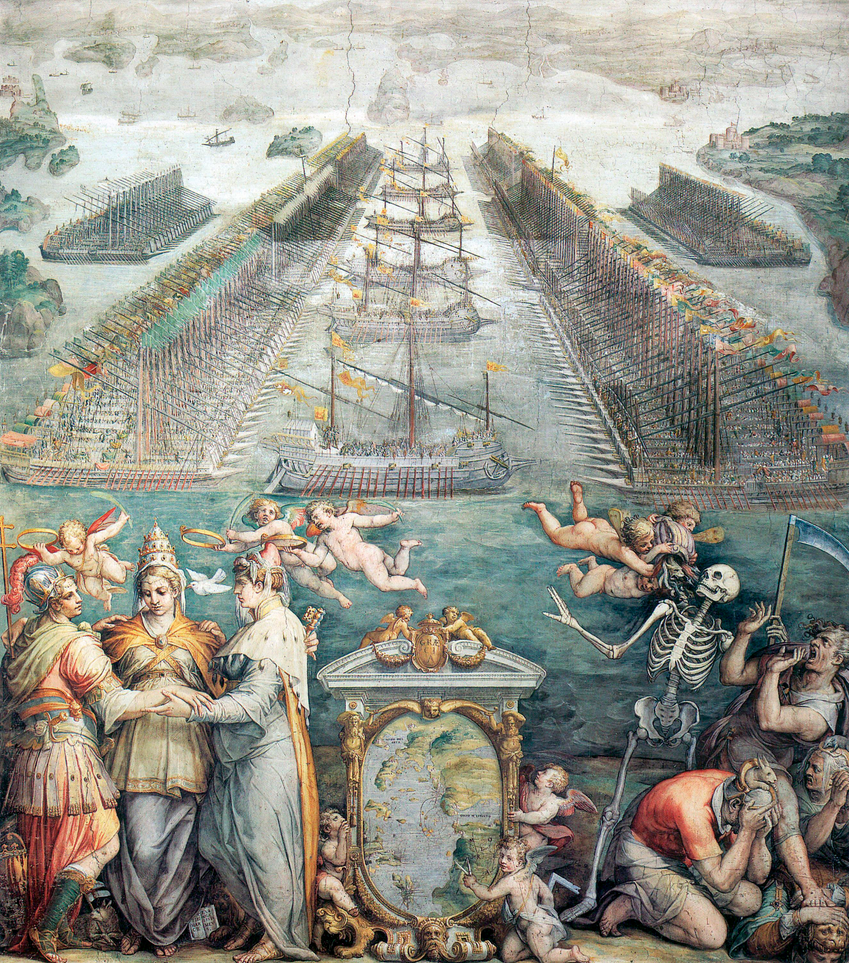


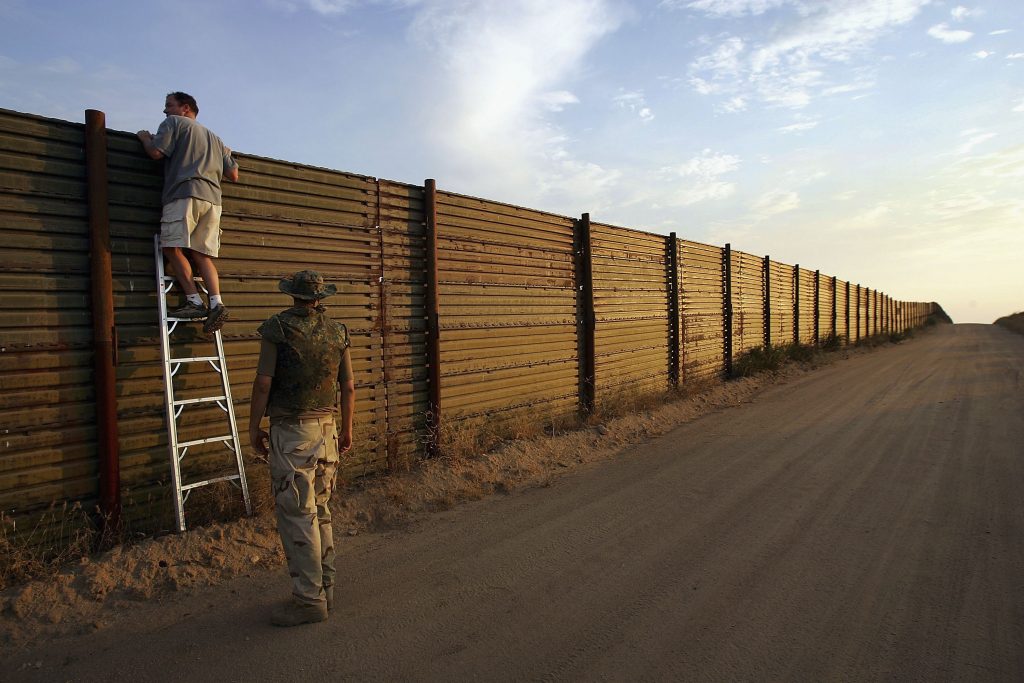





[…] (Men of the West): The Turk has long been known as the “sick man of Europe,” and the story of the Ottoman Empire […]